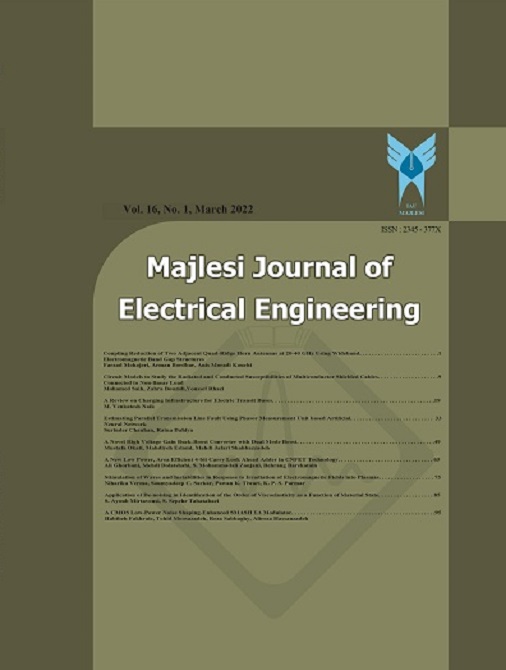[1] Fernández, E.F., Cruz, F.A., Mallick, T.K., Sundaram, S., "Effect of Spectral Irradiance Variations on the Performance of Highly Efficient Environment-Friendly Solar Cells," IEEE Journal of Photovoltaics, p1150-1157,2015.
[2] Braito, M.A.G., Galotto, J., Sampaio, L.P., Melo, G.E, Canexin, C.A., "Evaluation of the Main MPPT Techniques for Photovoltaic Applications", IEEE Trans. on Industrial Electronics, p1156-1167,2013.
[3] Fthenakis, V., Anctil, A. "Direct Te Mining: Resource Availability and Impact on Cumulative Energy Demand of CdTe PV Life Cycles", IEEE Journal of Photovoltaics, p433 -438,2016.
[4] M. Khamies, G. Magdy, M. Ebeed and S. Kamel, "
A robust PID controller based on linear quadratic gaussian approach for improving frequency stability of power systems considering renewables"
ISA Transactions,
vol. 117, pp. 118-138, 2021.
[5] Mohamed Ebeed and et al., "
Optimal integrating inverter-based PVs with inherent DSTATCOM functionality for reliability and security improvement at seasonal uncertainty, "
Solar Energy,
Vol. 267, pp.112200, 2024.
[7] S. E. I. Remache, A. Y. Cherif, and K. Barra, “Optimal cascaded predictive control for photovoltaic systems: Application based on predictive emulator,” IET Renew. Power Gener., vol. 13, no. 15, pp. 2740–2751, 2019.
[8] S. Farajdadian and S. M. H. Hosseini, “Optimization of fuzzy-based MPPT controller via metaheuristic techniques for stand-alone PV systems,” Int. J. Hydrogen Energy, vol. 44, no. 47, pp. 25457–25472, 2019.
[9] A. Mohapatra, B. Nayak, and C. Saiprakash, “Adaptive Perturb Observe MPPT for PV System with Experimental Validation,” 1st IEEE Int. Conf. Sustain. Energy Technol. Syst. ICSETS 2019, no. 1, pp. 257–261, 2019.
[10] N. Femia, G. Lisi, G. Petrone, G. Spagnuolo, and M. Vitelli, “Distributed maximum power point tracking of photovoltaic arrays: Novel approach and system analysis,” IEEE Trans. Ind. Electron., vol. 55, no. 7, pp. 2610–2621, 2008.
[11] M. N. Ali, K. Mahmoud, M. Lehtonen, and M. M. F. Darwish, “An Efficient Fuzzy-Logic Based Variable-Step Incremental Conductance MPPT Method for Grid-Connected PV Systems,” IEEE Access, vol. 9, pp. 26420–26430, 2021.
[12] G. Satheesh Krishnan, S. Kinattingal, S. P. Simon, and P. S. R. Nayak, “MPPT in PV systems using ant colony optimisation with dwindling population,” IET Renew. Power Gener., vol. 14, no. 7, pp. 1105–1112, 2020.
[13] C. Gonzalez-Castano, C. Restrepo, S. Kouro, and J. Rodriguez, “MPPT Algorithm Based on Artificial Bee Colony for PV System,” IEEE Access, vol. 9, pp. 43121–43133, 2021.
[14] T. Wang, S. Sun, D. Wan, T. Shao, and H. Wang, “Improved Photovoltaic Power Generation Maximum Power Tracking Method,” IOP Conf. Ser. Mater. Sci. Eng., vol. 452, no. 3, 2018.
[15] M. Seyedmahmoudian et al., “Maximum power point tracking for photovoltaic systems under partial shading conditions using bat algorithm,” Sustainability., vol. 10, no. 5, pp. 1–16, 2018.
[16] S. Jalali Zand, S. Mobayen, H. Z. Gul, H. Molashahi, M. Nasiri, and A. Fekih, “Optimized Fuzzy Controller Based on Cuckoo Optimization Algorithm for Maximum Power-Point Tracking of Photovoltaic Systems,” IEEE Access, vol. 10, no. July, pp. 71699–71716, 2022.
[17] Y. Soufi, M. Bechouat, and S. Kahla, “Fuzzy-PSO controller design for maximum power point tracking in photovoltaic system,” Int. J. Hydrogen Energy, vol. 42, no. 13, pp. 8680–8688, 2017.
[18] Li S. A "MPPT control strategy with variable weather parameterand no DC/DC converter for photovoltaic systems", Solar Energy,2014.
[19] S. Saremi, S. Mirjalili, and A. Lewis, “Grasshopper Optimisation Algorithm: Theory and application,” Adv. Eng. Softw., vol. 105, pp. 30–47, 2017.

